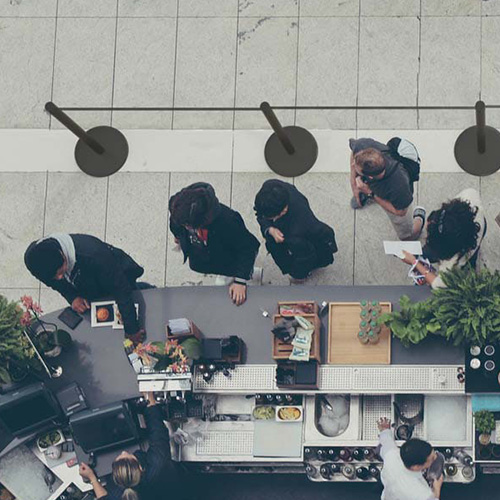
Table of Contents
Waiting Line Stress
Let’s face it no one likes to wait, especially by standing in line. Waiting for service is stressful, customers feel their time is being wasted, but how stressful the event is depends on how the waiting experience is managed. There are a number of ways in which poorly designed customer queues increase stress on patrons, here are a few common examples.
- A. No Queue
Faced with a mass of people and no evident organization a significant number of customer to simply walk away. Often this is caused during peak periods when the queue system’s capacity is exceeded and customers spill out from the end of the queue. - B. Badly Organized Queues
Where to enter, what to do when you get to the front, do you wait to be called, march right up, are you next, did that guy just cut in front? A badly organized queue is only just better than no queue at all. - C. Having to Choose a Line
A line for each cashier, which one to join? Count the number of people in each, assess the size of their baskets, what method do you use to choose? If you choose the wrong line you could be punished by a longer wait - D. Choosing the Wrong Line
So you chose the shortest line but a person in front of you is using coupons and paying by check. Now people who joined next line after you are getting served first. Aggravating? Very! - E. Switching Lines and Still Loosing
You know what I mean. The other line moves faster, so you switch then it immediately stops and the guy behind you in your first line moves ahead. That’s it, retail stress meltdown!
The Cost of Waiting Line Stress
Retailers and other service providers need to consider both the soft and hard costs of their customers having a stressful queuing experience. Excessive waiting can cause frustration even anger that damages the customer satisfaction that the organization has carefully worked to develop, this is the soft cost of waiting. Worse, excessive waiting line stress can lead to ‘walkaways’ – customers who refuse to join a queue or leave it before completing their transaction, this is the hard cost of waiting. This cost is relatively easy to measure, simply count the number of walkaways and multiply that by the average transaction value. The numbers can be frightening, for large retailers it can be in the tens of millions of dollars.
Waiting Line Stress Avoidance 101
You may not be able to eliminate waiting in line but it is really quite easy to reduce the waiting time and make the experience more relaxing, just follow these simple steps:
- 1. A Single Line is Always Best
With a single line servicing all cashiers the customer never has to; choose a line, worry about choosing the wrong line or stress about whether to change lines. Best of all the customer is guaranteed to be served in the order they arrived in the queue so they can relax. - 2. Make it Simple to Navigate
Design the queue corral so that the entrance is located in a logical, obvious position. Mark the entrance with signage, a simple “Please Enter Here” sign can make all the difference. Use signage at the head of the queue to tell the customer what to do e.g. “Please Wait Here” or “Wait to be Seated” etc. - 3. Ensure the Queue System has Sufficient Capacity
Make the queue corral large enough to handle peak traffic so the line does not spill out of the queue and become a mob! If you have sufficient floor space make a large corral and close off unneeded lanes during off peak periods using our twin belt Lane Closure stanchion. This saves customer the inconvenience of having to walk through the full system unnecessarily. If floor space is limited the queue can be expanded by bringing out more stanchions from storage using one of our storage carts. The alternative is to use stanchions with extra length belts and simply reposition the stanchions deploying more belt to expand the queue system. - 4. Inform and Entertain
Waiting is as much a psychological experience as a physical one. A 5 minute wait can either seem very long or very short depending on our state of mind. Boredom always makes a wait seem longer, to avoid this provide the customer standing in line with something to read or do. Post top signage can be used to inform about promotions or advise on relevant regulations. You can supply promotional literature using post top literature holders and if your service requires paperwork use post top writing tables, so customers can complete their paperwork while in the queue. - 5. Sell Them Something
By far the best option to engage and entertain customers standing in line is to sell them something. By fixing portable slatwall paneling between the stanchions you can fully merchandise the queue. People standing idle ar far more likely to interact with products and make a purchase, low value impulse type items merchandized in the queue typically see a 30%-50% uplift sales. Not only does merchandising the queue generate revenue from otherwise dead space it is the best way to entertain and therefor make the wait seem shorter.
The Benefits of a Well Designed Queue
Always remember that the checkout or service queue is the last touch point your organization has with the customer. Their experience here can completely change the perception of the overall service received during their visit. While no customer likes waiting most accept it as inevitable. What is important is that customer feels that the wait is limited by an efficient, fast and most of all relaxing queue system. With the few simple design ideas discussed in this article you can make the queue a driver of customer satisfaction and not a drag your organization’s reputation.


